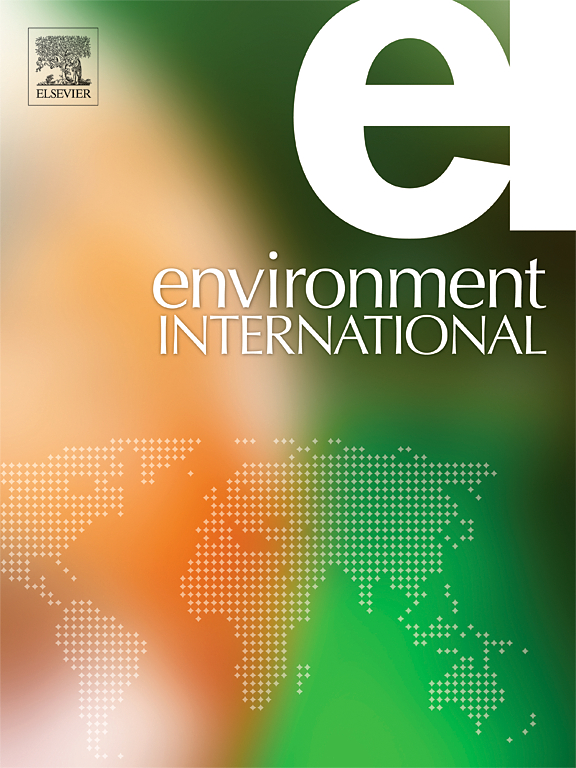6PPD/6PPD- q与天然铁锰结核的相互作用:吸附和氧化转化的性能和机制
IF 10.3
1区 环境科学与生态学
Q1 ENVIRONMENTAL SCIENCES
引用次数: 0
摘要
广泛使用的橡胶防老剂 N-(1,3-二甲基丁基)-N'-苯基对苯二胺(6PPD)及其臭氧产物 6PPD-quinone (6PPD-Q)对水生生物有剧毒,但对其环境行为的了解却很有限。本研究结合多种实验和计算方法,全面研究了它们在沉积物和土壤中常见的天然铁-锰结核(NFMN)上的吸附和转化过程。在 293 K 下,6PPD-Q 的最大吸附容量(719.2 μg-g-1)明显高于 6PPD 的最大吸附容量(133.8 μg-g-1),而且更难解吸。它们遵循不同的动力学和等温吸附模型,环境条件(包括温度、pH 值和阴离子)对这两种物质的吸附也有不同的影响。研究揭示了涉及静电吸引、电荷转移、氢键和路易斯酸碱络合的吸附机理。对于 6PPD 来说,静电吸附和路易斯酸碱络合对其吸附起了重要作用。相反,对于 6PPD-Q 来说,路易斯酸碱络合的作用超过了氢键的作用,而静电吸附的作用则相对微不足道。由于 NFMN 具有更强的静电吸引、更有效的电荷转移以及更多的氢键和路易斯酸碱络合结合位点,因此 6PPD-Q 的吸附作用更强。此外,在溶解锰(III)的促进下,6PPD 可以在 NFMN 上转化为 6PPD-Q。这项研究加深了人们对 6PPD 和 6PPD-Q 的吸附行为和机理的理解,并揭示了 6PPD-Q 形成的新途径,为评估水体暴露风险和制定此类污染物的环境修复策略提供了有价值的参考。 环境意义 这项研究首次全面揭示了 6PPD/6PPD-Q 与 NFMN 之间的相互作用,阐明了它们在水和土壤系统中的环境行为。它揭示了 6PPD 和 6PPD-Q 之间的吸附差异,并阐明了吸附差异的内在机制。此外,它还揭示了 6PPD-Q 形成的新途径,为风险评估和环境修复策略提供了宝贵的启示。本文章由计算机程序翻译,如有差异,请以英文原文为准。


Interaction between 6PPD/6PPD-Q and natural Fe-Mn nodules: Performance and mechanism of adsorption and oxidative transformation
The widely used rubber antioxidant N-(1,3-Dimethylbutyl)-N’-phenyl-p-phenylenediamine (6PPD) and its ozonated product, 6PPD-quinone (6PPD-Q), are highly toxic to aquatic life, yet understanding on their environmental behaviors is limited. This study comprehensively investigated their adsorption and transformation processes on natural Fe-Mn nodules (NFMN), which commonly exist in sediments and soils through a combination of diverse experimental and computational methods. The maximum adsorption capacity of 6PPD-Q (719.2 μg·g−1) is significantly higher than that of 6PPD (133.8 μg·g−1) at 293 K, and it is more difficult to desorb. They follow different kinetic and isothermal adsorption models, and environmental conditions (including temperature, pH, and anions) exert distinct influences on the adsorption of the two substances. Adsorption mechanisms involving electrostatic attraction, charge transfer, hydrogen bonding, and Lewis acid-base complexation were unveiled. For 6PPD, electrostatic adsorption and Lewis acid-base complexation contribute significantly to its adsorption. Conversely, for 6PPD-Q, the contribution of Lewis acid-base complexation outweighs that of hydrogen bonding, while the effect of electrostatic adsorption is relatively negligible. The stronger electrostatic attraction, more efficient charge transfer, and a greater number of binding sites for hydrogen bonding and Lewis acid-base complexation with NFMN results in more robust adsorption of 6PPD-Q. Furthermore, 6PPD can transform into 6PPD-Q on NFMN, facilitated by dissolved Mn(III). This study advances understanding of the adsorption behavior and mechanism of 6PPD and 6PPD-Q, and highlights a new pathway for 6PPD-Q formation, which provides valuable reference for assessing the water body exposure risks and formulating environmental remediation strategies for such pollutants.
Environmental Implication
This study offers the first comprehensive insight into the interactions between 6PPD/6PPD-Q and NFMN, illuminating their environmental behavior in water and soil systems. It reveals the adsorption discrepancy between 6PPD and 6PPD-Q, and elucidates the mechanisms underlying the difference in adsorption. Additionally, it uncovers a novel pathway for 6PPD-Q formation, offering valuable implications for risk assessment and environmental remediation strategies.
求助全文
通过发布文献求助,成功后即可免费获取论文全文。
去求助
来源期刊

Environment International
环境科学-环境科学
CiteScore
21.90
自引率
3.40%
发文量
734
审稿时长
2.8 months
期刊介绍:
Environmental Health publishes manuscripts focusing on critical aspects of environmental and occupational medicine, including studies in toxicology and epidemiology, to illuminate the human health implications of exposure to environmental hazards. The journal adopts an open-access model and practices open peer review.
It caters to scientists and practitioners across all environmental science domains, directly or indirectly impacting human health and well-being. With a commitment to enhancing the prevention of environmentally-related health risks, Environmental Health serves as a public health journal for the community and scientists engaged in matters of public health significance concerning the environment.
 求助内容:
求助内容: 应助结果提醒方式:
应助结果提醒方式:


